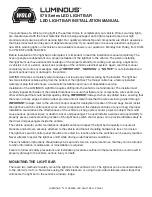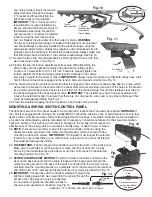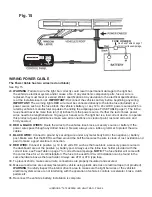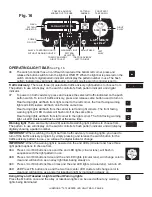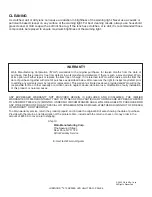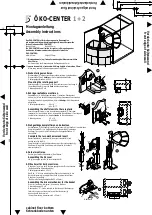
LUMINOUS™ 570 SERIES LED LIGHT BAR - PAGE 3
MOUNT LIGHT BAR - STAINLESS-STEEL STRAPS
11. There are two mounting brackets on the bottom of the light bar, one on each
end. Loosen the four nuts on one bracket and the bracket will freely slide, repeat
procedure for the other bracket. Do not tighten the nuts until the brackets have
been positioned with the stainless-steel straps. See Fig. 5.
12. Place the light bar on the selected location of the vehicle’s roof. A preferred
mounting position on the roof is close to the B-pillar, which is the strongest part
of the roof. IMPORTANT: Make sure the light bar is facing the correct direction.
NOTE: There is a label on the lens indicating “FRONT”.
13. Make sure the selected
mounting location of
the light bar will allow
the stainless-steel
straps to attach to the
vehicle window ledge
on both the driver’s and
passenger sides. See
Fig. 6.
14. Drill a 1/2″ hole into the roof, which will be the access point to route the cables into the interior of the
vehicle. Mark the desired hole location; remove the light bar from the roof and drill the hole. The installer
must lower the headliner to carefully inspect selected location to ensure that there are no components,
wires and or any other vehicle parts that could be damaged before drilling. WARNING: The roof has
support members that spans from the driver’s side to the passenger’s side of the vehicle. NEVER drill into
a support member! It will be necessary to relocate the cables access hole either in front or behind support
member.
15. IMPORTANT: Protect the vehicle’s interior headliner from damage that could be caused when drilling the
access hole for the light bar’s electrical cables. It’s recommended to allow a minimum distance of 6” to 8”
between the roof and headliner by lowering the headliner before drilling the access hole.
16. IMPORTANT: Always de-burr the access hole that was drilled by using a round file
to ensure there are no sharp edges. NOTE: Provided with the light bar is a rubber
grommet. Insert the rubber gromet into the access hole, place the light bar on the roof
of the vehicle. Route the thin wire cable with the plug through the rubber grommet first,
followed by the heavier gauge wire cable. See Fig. 7 & 8.
17. The cables will make an approximate 90° bend into the B-pillar. Depending on the
vehicle, this can sometimes be difficult, but it is the recommended procedure for
a proper installation. Installation can vary for each make and model vehicle, and it
is up to the installation technician’s discretion whether to route the power cable as
recommend through the B-pillar or use an alternative routing method. Route cables
down to the bottom of the B-pillar and pull the full length of both cables into the
interior of the vehicle. See Fig. 9.
18. Position the light bar into mounting position onto the roof. The two adjustable slide
brackets located on the bottom of the light bar are positioned outward toward the edge of the roof. The
installer will need to adjust the location of the two brackets with the stainless-steel straps. See Fig. 10.
19. Open the vehicle’s door and determine the location that the stainless-
steel strap will clamp onto the windows ledge. You may need to move
the rubber weather strip away from the vehicle. Only remove enough
weather-strip so that the area where the stainless-steel strap will be
secured to the vehicle is exposed. NOTE: The installer will have to
bend and shape each strap to contour of the window ledge. Repeat
the procedure for other side of vehicle.
20. Remove the protective film covering the stainless-steel straps. Place
one of the stainless-steel straps into position on the window ledge
so the installer can determine which holes in the stainless-steel strap
is best positioned to attach the “L” bracket using the bolts, washers
Fig. 8
RUBBER
GROMMET
Fig. 7
Fig. 9
B-PILLAR
THIN CABLE WITH
PLUG AND HEAVY
GAUGE CABLE EXIT
Fig. 5
Front View
Fig. 6
DRIVER’S SIDE
PASSENGER’S SIDE

